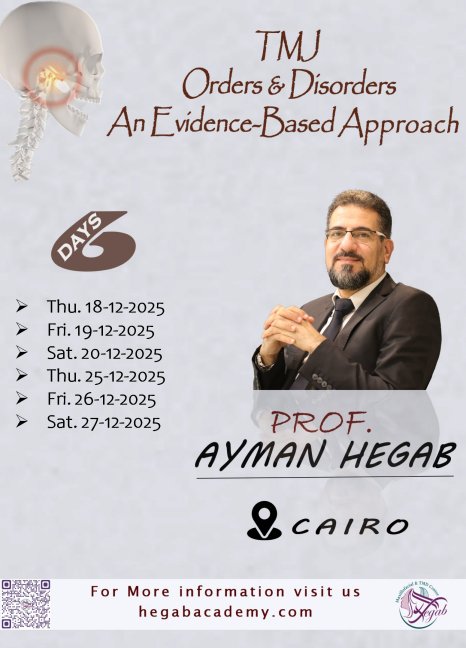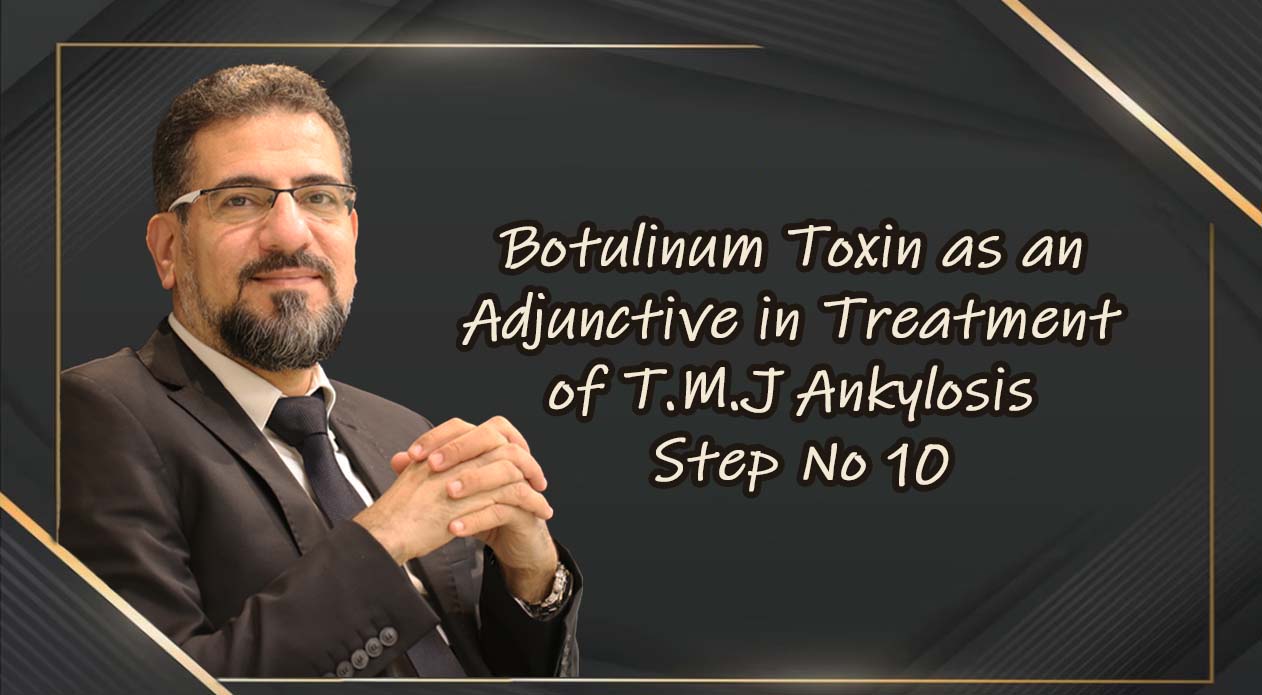Prof. Ayman Hegab is a Professor of Oral & Maxillofacial Surgery, Faculty of Dental Medicine. Al-Azhar University. Cairo. Egypt.
Editorial
The treatment of TMJ Ankylosis is very challenging, not only
in achieving adequate facial aesthetics and oral rehabilitation,
but also in preventing re-ankylosis. One of the most important
extra-articular factors of TMJ re-ankylosis is the activity of the
masticatory muscles. Following condylar injury, mandibular
movements are restricted due to pain. The restriction of the
mandibular movements is brought about by the activity of elevator
muscles of the mandible, which may act like a biologic splint. The
masticatory muscles in these conditions adapt to a restricted
range of mouth opening by shortening. Thus, these muscles
could become an additional, extra-articular cause of mandibular movement restriction. These effects are generally more evident
when joint pathology exists for a longer period [1]. Two different
pathologic changes could be associated with the prolonged TMJ
ankylosis which includes Degenerative changes or hypertrophy.
It is a well-established phenomenon that skeletal muscles
undergo disuse atrophy when they are not in use [2]. In TMJ
Ankylosis, where the mandible is in a chronic state of closure,
the logical inference would thus be that the elevator muscles
would undergo degenerative changes or disuse atrophy. It has
been suggested that prolonged TMJ ankylosis inhibits the normal
use of the joint, are associated with degenerative changes in the
masseter, medial pterygoid and temporalis muscles inducing
reflex muscle splinting to protect the joint [1].
While; Vinay et al evaluates thickness and cross-sectional areas
of jaw elevator muscles and indicates that muscle hyperactivity
might be associated with ankylosis. A probable hypothesis
would be that regular mandibular movements are more difficult
to perform due to the stiffness in the joint, which subsequently
resulted in increased thickness of the muscles due to the increased
functional demand. It could also be that the increased muscle
thickness is due to shortening of the muscle, because the height
and length of the affected mandibles are smaller than normal [3].
Recently; a protocol for management of TMJ ankylosis consisted
of nine steps based on the Pathhogenesis of Ankylosis and ReAnkylosis have been published.
While; Vinay et al evaluates thickness and cross-sectional areas of jaw elevator muscles and indicates that muscle hyperactivity might be associated with ankylosis. A probable hypothesis would be that regular mandibular movements are more difficult to perform due to the stiffness in the joint, which subsequently resulted in increased thickness of the muscles due to the increased functional demand. It could also be that the increased muscle thickness is due to shortening of the muscle, because the height and length of the affected mandibles are smaller than normal [3]. Recently; a protocol for management of TMJ ankylosis consisted of nine steps based on the Pathhogenesis of Ankylosis and ReAnkylosis have been published.
The protocol consisted of the following steps:
a. Perioperative indomethacin for 2 weeks;
b. The creation of a minimal gap of 5 to 10 mm;
c. Ipsilateral coronoidectomy and (if required) contra lateral
coronoidectomy;
d. Pterygomasseteric sling and temporalis muscle release;
e. Interpositional dermis fat graft fixed to the condylar stump;
f. Insertion of a suction drain;
g. Immediate aggressive physiotherapy for at least 6 months;
h. Regular long-term follow-up;
i. Delayed reconstruction using distraction osteogenesis[1].
Botulinum toxin type A (BTA) are purified substances that
derived from clostridium botulinum, and can block muscular
nerve signals. Injection of very small amounts of BTA into specific
facial muscles can block the muscle’s impulse and temporarily
weakens the contraction of muscles by blocking the presynaptic
cholinergic nerve endings, thus causing relaxation of the voluntary
muscle [4]. Therefore, it will results in reducing the activity of
elevator muscles of the mandible. It has been shown clinically that
injection of Botulinum toxin, as an adjunct to surgical therapy, in
the masseter muscles of patients operated for TMJ Ankylosis has
improved outcomes [5]. Based on this concept, I would like to
add the preoperative injection of Botulinum toxin in the masseter
muscles, as an adjunct pre-operative step to the surgical protocol
to surgical therapy, to improve the outcomes.
b. The creation of a minimal gap of 5 to 10 mm;
c. Ipsilateral coronoidectomy and (if required) contra lateral
coronoidectomy;
d. Pterygomasseteric sling and temporalis muscle release;
e. Interpositional dermis fat graft fixed to the condylar stump;
f. Insertion of a suction drain;
g. Immediate aggressive physiotherapy for at least 6 months;
h. Regular long-term follow-up;
i. Delayed reconstruction using distraction osteogenesis[1].
Botulinum toxin type A (BTA) are purified substances that
derived from clostridium botulinum, and can block muscular
nerve signals. Injection of very small amounts of BTA into specific
facial muscles can block the muscle’s impulse and temporarily
weakens the contraction of muscles by blocking the presynaptic
cholinergic nerve endings, thus causing relaxation of the voluntary
muscle [4]. Therefore, it will results in reducing the activity of
elevator muscles of the mandible. It has been shown clinically that
injection of Botulinum toxin, as an adjunct to surgical therapy, in
the masseter muscles of patients operated for TMJ Ankylosis has
improved outcomes [5]. Based on this concept, I would like to
add the preoperative injection of Botulinum toxin in the masseter
muscles, as an adjunct pre-operative step to the surgical protocol
to surgical therapy, to improve the outcomes.
d. Pterygomasseteric sling and temporalis muscle release;
e. Interpositional dermis fat graft fixed to the condylar stump;
f. Insertion of a suction drain;
g. Immediate aggressive physiotherapy for at least 6 months;
h. Regular long-term follow-up;
i. Delayed reconstruction using distraction osteogenesis[1].
Botulinum toxin type A (BTA) are purified substances that
derived from clostridium botulinum, and can block muscular
nerve signals. Injection of very small amounts of BTA into specific
facial muscles can block the muscle’s impulse and temporarily
weakens the contraction of muscles by blocking the presynaptic
cholinergic nerve endings, thus causing relaxation of the voluntary
muscle [4]. Therefore, it will results in reducing the activity of
elevator muscles of the mandible. It has been shown clinically that
injection of Botulinum toxin, as an adjunct to surgical therapy, in
the masseter muscles of patients operated for TMJ Ankylosis has
improved outcomes [5]. Based on this concept, I would like to
add the preoperative injection of Botulinum toxin in the masseter
muscles, as an adjunct pre-operative step to the surgical protocol
to surgical therapy, to improve the outcomes.
f. Insertion of a suction drain;
g. Immediate aggressive physiotherapy for at least 6 months;
h. Regular long-term follow-up;
i. Delayed reconstruction using distraction osteogenesis[1].
Botulinum toxin type A (BTA) are purified substances that
derived from clostridium botulinum, and can block muscular
nerve signals. Injection of very small amounts of BTA into specific
facial muscles can block the muscle’s impulse and temporarily
weakens the contraction of muscles by blocking the presynaptic
cholinergic nerve endings, thus causing relaxation of the voluntary
muscle [4]. Therefore, it will results in reducing the activity of
elevator muscles of the mandible. It has been shown clinically that
injection of Botulinum toxin, as an adjunct to surgical therapy, in
the masseter muscles of patients operated for TMJ Ankylosis has
improved outcomes [5]. Based on this concept, I would like to
add the preoperative injection of Botulinum toxin in the masseter
muscles, as an adjunct pre-operative step to the surgical protocol
to surgical therapy, to improve the outcomes.
h. Regular long-term follow-up;
i. Delayed reconstruction using distraction osteogenesis[1].
Botulinum toxin type A (BTA) are purified substances that
derived from clostridium botulinum, and can block muscular
nerve signals. Injection of very small amounts of BTA into specific
facial muscles can block the muscle’s impulse and temporarily
weakens the contraction of muscles by blocking the presynaptic
cholinergic nerve endings, thus causing relaxation of the voluntary
muscle [4]. Therefore, it will results in reducing the activity of
elevator muscles of the mandible. It has been shown clinically that
injection of Botulinum toxin, as an adjunct to surgical therapy, in
the masseter muscles of patients operated for TMJ Ankylosis has
improved outcomes [5]. Based on this concept, I would like to
add the preoperative injection of Botulinum toxin in the masseter
muscles, as an adjunct pre-operative step to the surgical protocol
to surgical therapy, to improve the outcomes.
Botulinum toxin type A (BTA) are purified substances that derived from clostridium botulinum, and can block muscular nerve signals. Injection of very small amounts of BTA into specific facial muscles can block the muscle’s impulse and temporarily weakens the contraction of muscles by blocking the presynaptic cholinergic nerve endings, thus causing relaxation of the voluntary muscle [4]. Therefore, it will results in reducing the activity of elevator muscles of the mandible. It has been shown clinically that injection of Botulinum toxin, as an adjunct to surgical therapy, in the masseter muscles of patients operated for TMJ Ankylosis has improved outcomes [5]. Based on this concept, I would like to add the preoperative injection of Botulinum toxin in the masseter muscles, as an adjunct pre-operative step to the surgical protocol to surgical therapy, to improve the outcomes.
References
(1) Hegab AF (2015) Outcome of Surgical Protocol for Treatment of Temporomandibular Joint Ankylosis Based on the Pathogenesis of Ankylosis and Re-Ankylosis. A Prospective Clinical Study of 14 Patients. J Oral Maxillofac Surg 73(12): 2300-2311.
(2) Chinnery PF (2011) Muscle Diseases. In: Goldman L, Schafer AI (Eds) Cecil Medicine. (24th edn), Saunders Elsevier, Philadelphia, USA, pp. 429-436.
(3) Kumar VV, Malik NA, Visscher CM, Ebenezer S, Sagheb K et al. (2014) Comparative evaluation of thickness of jaw closing muscles in patients with long-standing bilateral temporomandibular joint ankylosis: a retrospective case-controlled study. Clin Oral Investg 19(2): 421-427.
(4) To EW, Ahuja AT, Ho WS, King WW, Wong WK et al. (2001) A prospective study of the effect of botulinum toxin A on masseteric muscle hypertrophy with ultrasonographic and elec
(5) Robiony M (2011) Intramuscular Injection of botulinum toxin as an adjunct to total joint replacement in temporomandibular joint ankylosis: preliminary reports. J Oral Maxillofac Surg 69(1): 280- 284.



